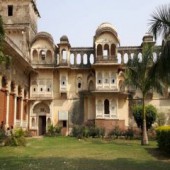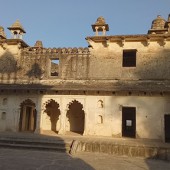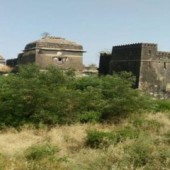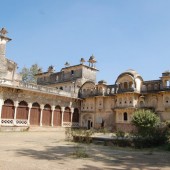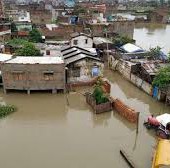Sheopur
About:
Sheopur District is a district of Madhya Pradesh state in central India. The district is located in the north of the state and forms part of Chambal Division.The well-known Kaketa reservoir is located in this district. The art of woodcarving has flourished in district Sheopur and the beautifully embellished wooden ceilings, doors and lintels with finely carved designs are silent testimonials of its glory.
The town of Sheopur is the district headquarters. Other towns include Bijeypur, Karahal and Badoda. The district has a population of 559,715 (2001 census) and covers an area of 666,081 km².With wheat, mustard and bazra as the most grown crops, Sheopur has an agrarian economy. The district is also known for its wood curved handicrafts.
The Kuno wildlife sanctuary of Sheopur can be a memorable visit for the tourists and travelers. This well connected district has a total area of 6,66,081 square kilometers and a population of 5,59,715. The district is divided into two subdivisions of Sheopur and Vijaypur.
Location info:
Sheopur is located at 25.67°N 76.7°E. It has an average elevation of 229 metres (751 feet).
Climate/Weather:
The average rainfall in the area is 750 mm per year. The maximum temperature can rise up to 49 degree C while the minimum temperature recorded has been 2 degree C.
History of Sheopur
There is no conclusive documented source available to tracing the historical origin of Sheopur Fort. However a Jain pillar edict dated 1026 A.D. refers to the existence of the Sheopur fort. The 11th A.D. the famous poet Khadag Rai of Gwalior in his renowned work Gopanchal Akyan mentions Sheopur. According to his account the king of Nareshar Ajay Pal (1194-1219) had declared Sheopur as his capital
In 1301 A.D. ‘Allauddin Khilji’ on winning the Ranthambhor fort captured the Sheopur fort also which was under king Hammir Dev at that time. In 1489, Sultan Mahmood Khilji of malwa won it and established an integrated part of malwa Sultanate.
In 1542, Sher Shah Suri captured the Sheopur fort. During his time an Idgah and after his death or grand masolum of his commander Munabber Khan made by his son Islam Shah is the interesting example of Architecture of that time.
After that Surjan Singh Hada the King of Boondi captured Sheopur fort. In 1547, Akbar captured the fort and consequently it because part of Gwalior Maharaja Daulat Rao Scindia had to fight the Gour king Radhika Das to capture the fort the Gours of Agra had been awarded the Sheopur fort as karad kings by Mugals and generations of Vats Raj Gour continued to rule from it, before succumbing to the Scindias.
The 225 years history of the Sipahad kingdom’ as it is called a saga of untold valur and forcefully independent cultural identity. This is reflected there architectural remains, which are individual thriving tradition of performing art, paintings, sculpture and highly artistic style of living. The individual palace of Narsingh Gour, Rani mahal or Goojri mahal are striking examples of Gour architecture. The chhartries built as a mark of respect for the king Indar Singh Gour & and Kishor Das Gour after the demis is silent and solemn examples of symmetrically well-crafted architecture. The Scandias remained in control of the fort till India acquired independence. They contributed of the grandeur of the fort by adding new dimensions to its resplendent remarks. The late Maharaja Madavrao Scindia built a Diwan-A-Aam, The Darbar Hall, and a state guesthouse presently the Diwan-A-Aam.
The site of a Sahariya Museum, this is a window to the word of Saharia life partners, who rank as one of few existing primitive tribes of India. A few portion of the fort have been taken over by the M.P. Archeological Department for protections and conservation.
Educational Institutions in Sheopur:
Sheopur has one of the world’s best education systems and the central board of education or better known as CBSE plays a vital part of it.
One popular school is Jawahar Navodaya Vidyalaya School.
Science colleges in Sheopur usually offer B.Sc. (Bachelor of Science) and a similar post graduation course for 2 years duration called the M.Sc. (Master of Science). Colleges for science in Sheopur have been planning to make the course much more lucrative and useful to students; therefore a proposal was made to the Indian government asking them to make to course to be of 4 year duration. The UGC (University Grants Commission) is looking up at this and has taken a few decisions in this regard, if colleges of science in Sheopur are able to make the course much more structured and well poised for the future, then it would surely be good for all those students who are planning to pursue the course in the near future.
Langauges:
Hindi and other regional languages
Culture:
In Sheopur the major spoken language is Hindi. Including the main festivals of India, Sheopur has few local festivals also and they are-
Tansen Festival:-
Every year a national-level music festival is organized in November/December near the tomb of Mian Tansen, one of the `Nine Jewels` of Emperor Akbar’s court. Musicians and singers from all over India come here to perform in the festival.
Folk Dances
Ahiri Dance:-
This dance is related to people who have traditionally been in the business of cattle herding. In different parts of the state these people are known by different castes such as Ahir, Baredi, Gwal, Rawat, Raut, Gwala etc.
Baredi or Yadav dance of Bundelkhand:-
This dance has been associated with the biggest Hindu festival “Diwali”. On the night of Diwali people worship Laxmi, the Hindu goddess of wealth (after all no body can live without money), and cattle. Next day on the occasion of “Padva” or “Parva” cattle are sent to jungles or ranches after being decorated with flowers and garlands. They are given special dishes as food. Yadav dance is performed on the same occasion. Dancers dance in a circular path while singing songs. Sometimes they sit or lie down on earth and suddenly they restart their dance. Rhythm of the song is very low in starting and increases with time. Music instruments are started only when two lines of the song are finished. Primarily these are two line couplets. Sometimes these are in form of questions and answers. This dance continues till Kartik Purnima.
Dress:-
Dancers, instrument beaters and their associates wear a clean turban on head. Some people like to put on Dhoti up to knees (long cloth wore by men enwrapping their waist). Some people specially dancers wear colorful shorts. Dancers also keep bunch of peacock feathers.
Saharia Dances:-
Saharias are tribal people who live in jungles. They work in farms and also collect medicinal plants from jungles. There are several dances of Saharias. Some of the important ones are: Lur Dance, Lanhgi Dance, Dul-Dul Ghodi Dance, Raya Dance, Ada-Khada Dance.
Lur dance of Saharias:-
This dance is performed on the occasion of marriage starting from the day of ritual of “Haldi” (In this ritual whole body is pasted with turmeric and after sometime it is removed so the body is cleaned) till the arrival of Barat (Bridegroom comes to the house of the bride with his relatives and friends for marriage ceremony).
Lanhgi dance of Saharias:-
This dance is also known as Danda(baton) dance because Saharias dance with small batons in their hands with which they strike at each other and perform Lanhgi dance. Only men are allowed in it. This dance is performed on the occasion of Bhujarias, Teja ji puja and Aekadashi etc.
Dul-Dul Ghori dance:-
This dance is performed on the occasion of marriage by males. In this dance a hollow case of ghori (mare) is prepared of bamboo sticks. The dancer stands in the hollow place and dances. (Depicts various movements of mare.) There is also a joker in women clothing. People sing folk songs during the dance.
Musical instruments:-
Mradang, Dholak, Ramtula, Dhapli, Manzira, Jhanz etc. are used in this dance.
How to reach Sheopur?
Nearest Railway Station:
As with other light railways in the former princely state of Gwalior (now part of the Central Railway in Madhya Pradesh) these 200 km of 610mm gauge lines were originally sponsored by the Maharaja of Gwalior, reaching Sheopur in 1909. This railway line is just nominated by Indian government for the World Heritage site.
Nearest Airport:
The nearest airport to Sheopur is Gwalior. This airport is well connected with Delhi, Bhopal, Indore and Mumbai.
Road Transport:
Sheopur is connected by regular bus services with Gwalior, Morena, Sheopur and Kota. Sheopur is 210 km from Gwalior and 230 km from Morena.
Tourist Attraction of Sheopur:
Doob Kund:-
In Sheopur district, there was a city in the Chambal valley of Sheopur tehsil at some distance from river Kuno known as `Dom`. It was the capital of Kachhwaha Kingdom. Here stands 81 feet high, large and square `Chaubisi of Jain Tirthankaras`, which is still worth seeing. The pillars standing on the `Kalash` remind us of the art of their architects. In the middle of the Chaubisi, one could see a kund where the statues where sunk. Since than, it is called Doob Kund. Outside it, there are the remains of Har Gauri Temple. This statuary group was built in 11th century.
Ram-Janki Temple:-
It is situated at the bank of SEEP river, near to the fort of the sheopur. You can easily reach here by local transport system. this temple was built in the 15th century and is famous for ram-janki statue. The mahant of the temple is shri Rambharos ji maharaj. Every year a big celebration is held on the occasion of Ramnavami, which is the main attraction of the temple.
Sangam Of Rameshwar:-
It is situated in the semicircle of rivers `Parvati` and`Chambal` is full of natural beauties. It is 959 feet high from seashore. Since rivers`Parvati` and `Chambal` join here, the city is called the `Sangam of Rameshwar`. A local fair is held here every year. It is an attraction for the tourists especially for the people of Rajasthan.
Vijaypur Durg:-
At the bank of river `Kunari`, there stands a fort known as `Majhola durg`. Vijay Singh, the King of Karoli, built it.
Other places:-
The Fort of Sheopur
Dhuruvkund and Shivnath of Utanwad
The Muth of Nimoda
The temple of Devi Panwara
The temple of Shironi Hanuman
The water temple of Baroda
The temple of Khhetrapal Jaini
Kuno wildlife sanctuary:
Kuno wildlife sanctuary, located between latitudes 25degree 30second – 25degree 53second N and longitudes 77degree 07second – 77degree 26second E, is situated in the Sheopur district of north-west Madhya Pradesh. The total area is 344.686 sqkm out of which 313.984 sqkm is forest land and 30.702 sqkm is revenue land in the Sheopur and Vijapur tehsils of Sheopur district.
This sanctuary is situated at Vijaypur and Sheopur tehsils in Sheopur district. It is 15 km. from the Sesaipura bus stand on Shivpuri-Sheopur road. It can be approached by bus or taxi from Sesaipura bus stand. It can also be approached from Pohari of district Shivpuri at the distance of 25 km. The sanctuary is situated in an isolated hill, sloping in all directions.
All the faunal representatives of the dry deciduous forest of the Central India can be found in Kuno i.e. Panther, Tiger, Chital, Sambhar, Black Deer, Chinkara, Bear, Blue bull, Chausingha, Jungle cat, Barking Deer, Monkey, Jackals, Hyena, Wild Boar, Fox, Kobra, Nag, Python, Peacock, Kala Teetar, Tree pie, Golden orioles, Drongo, Rollers, Jangli, murgi, Phakta, Bhura, Teetar.
The Kuno sanctuary consists of dry deciduous forests interspersed with grasslands. Tree : Kardhai, Gurjan, Kher, Kusum, Gurjan, Mahua, Guner, Haldoo, Kullu, Kahua, Semal, Bahera, Tendu, Palas, Bel, Chind, Anwala, Harsingar, Chind, Satawar; Parasites : Bamdha, Amarbel;Grasses : Doob, Lumpy, Machai, Guner, Ponea, Phulara.
